Hopefully, there's now a deer in range.
Decision time!
First and foremost: is this deer able to be legally harvested? Do you have a tag for it? Does it meet any antler restrictions?
Wait, antler restrictions??
Some states are trying out ways to improve the quality of the herd and increase the age of the herd. Lots of hunters are taking spike bucks and small forks, instead of letting them go another couple years to turn into nice six- and eight-point mature bucks. Trial programs are generally point restrictions of the, "At least three points on one side," variety.
Private landowners who are trying to bring home a trophy rack are also trying what's called "Quality Deer Management" in order to see some bigger racks. They'll often have a standing rule that you must shoot a doe before you can take a buck, and any buck taken must have six or more points, and/or a spread outside the ears, etc. They may also eliminate non-typical racks on a shoot-on-sight basis. On a large piece of private land, this can work wonders if all the hunters buy in to it. Anecdotally, hunters are seeing more big racks - in points, spread, and mass.
Presuming you have a tag, and it meets antler restrictions (either state-issued or a QDM program), or is a doe (antlerless), it's time to decide if it's worth shooting. There are plenty of deer out there that aren't worth a shot. This year's fawns are still going to be very small deer, and a fair number of last year's won't be much bigger.
Whether a deer is worth shooting gets into ethics in a major way. If you're a trophy hunter, you know what's a trophy to you. I'm of the mindset that, "You can't eat antlers." I'm hunting for meat, not for a trophy. That said, if there is a nice rack standing next to a nice doe, all other things equal, I'm taking the rack. If you're a new hunter, you're probably in the, "If it's brown, it's down," phase - and that's ok. Most hunters get out of that in the first season or two and will be a bit more selective about what they're taking. Of course, if it's late in the season, the freezer is empty, and you haven't had a chance at anything ... well, most anything goes at that point.
Now we get into shot placement and ethical shots, and I've got some wonderful illustrations here. Pardon my MS Paint skills, and any picture can be clicked for a larger view. I've roughly outlined the place to aim for on each deer. The "perfect" killing shot will be through the heart and both lungs. This doesn't happen often. A lung and the heart, both lungs but no heart, neck/back ... that's reality. You'll be contending with weird angles and moving targets.
We'll start with the textbook broadside shot. They really don't get much better than this. Unafraid, watching the world, with a clear shot into the chest.
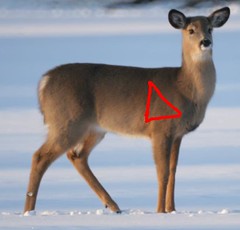
This is a more common view, known as the "quartering away" shot. Because of the angle, you need to aim a bit further back on the deer to have a good chance of hitting a vital organ - but you don't want to penetrate the entrails.
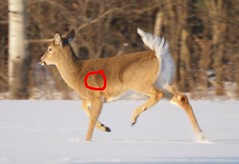
This one is pretty questionable in my book. The angles are bad, you can't really tell where the chest is, and curled up like that it's very easy to miss by a little and end up with a gut-shot deer. A grunt call or a whistle ought to get this deer to stand up, presenting a better shot for you.
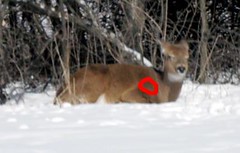
Now here's a gimme, right? Nice deer, good backstop, just a few twigs in the way... Only problem: that slug or bullet is going to go through the chest, tear up the heart and lungs - and keep on going. Right into the entrails. You'll end up with a soupy bloody mess of lung tissue and partially digested browse. Not a pleasant thing to deal with, and really not an ethical shot. Wait five minutes; she'll turn one way or the other and present a better angle.
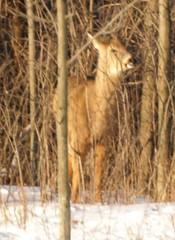
How about a two-fer? Can you tell where one starts and the other stops? You've got a decent angle on the one in front, but your slug may well go right on through and only injure the second. A wounded deer can run for, quite literally, miles - and as an ethical sportsman, it's your responsibility to make every effort to recover a wounded animal. The one in back might as well be purely head-on - see above. Again - wait. They'll turn and/or separate, and you'll get a shot.
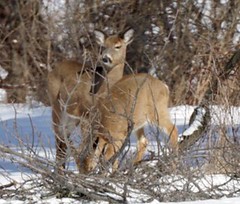
This fellow is at a full-on gallop. Something spooked him, and he's un-assing the area pronto. There is no such thing as an ethical shot at a deer running like this. Let me repeat that. There is no such thing as an ethical shot at a deer running like this. You can try a couple things. A quick shout, or yelp, or whistle may stop him long enough for you to get a shot. Or it may not - in which case you should just settle back and enjoy watching him run, then start looking for the next one.
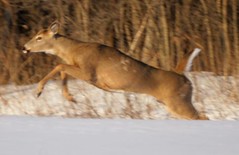
These are, of course, just a few examples, and you will need to use your own judgment and sense of morality in making shots. I can't tell you what's right or wrong, just my opinions. If you want to dump a magazine at that running button buck*, that's your discretion. Just remember that a lawyer comes free with every bullet you fire and there are going to be other hunters in the woods.
With the deer in your sights, the shot should be instinctive. Just like a day at the range, right? Front sight, take a breath, let half out, hold it, squeeze, follow through... Yeah, right. Buck fever is a very real thing, and doesn't apply exclusively to bucks. Having a deer in your sights will jump your heart rate in a very real way. The gun will feel shaky, you may fumble (or forget) the safety, you'll get a bit of tunnel vision... Take a deep breath and calm down.
A miss is wasted ammo, and a spooked deer. At $2-3 per shot for premium hunting ammo, that gets expensive real fast, and doesn't fill the freezer. Get your sight picture, find a rest for the gun if you can, and make the shot count. Call your shot. Know where it hit, and watch how the deer reacts. A missed deer will usually jump straight up or ahead. A gut-shot deer will hunch up around the bullet. A good chest hit may hunch up but will usually stumble a little.
After the shot, watch the deer. Don't climb out of your stand or blind, don't try for another deer, just watch the one you shot. See where it runs and how it's running. Is the gait uneven or a solid run? Is it heading for thick cover or water? Open fields? Watch it until you can't see it anymore, then sit your butt back down and concentrate on remembering what you just saw. Did the shot feel right? Did the deer act "hit" or just spooked? Where did it run? In your mind, mark the exact spot it was in when you took your shot, and the exact path it took as it ran. Which trees did it go around? What brush did it go through? (If you are hunting in snow, this is made far easier, but don't assume you'll have that benefit.)
Tomorrow we'll cover tracking...
* - How can I tell that's a button buck? Look at the head. A doe will have a more slender, domed head, particularly when viewed from the front. A button buck will have a square shape from the antler bases, which are pretty easy to see in profile as small nubbins above and behind the eyes. Am I 100% sure? No, not in this case. But it's a good indicator to remember.


No comments:
Post a Comment